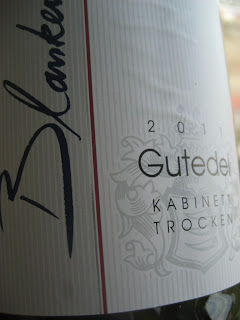
Following on from an
unusual wine last year, I'm giving Egringen's favourite winery
Weingut Brenneisen some more coverage today with a Pinot Noir dating back a few years. The Brenneisen family sell their wares (fruit and veg, home-made bread,
pastries, eggs, flowers and wine) every Saturday in front of
Matthäuskirche here in Kleinbasel (i.e. Basel on the right bank of the Rhine). I've heard good things about them since my first encounter, so now it's time for something more "conventional", shall we say, within a Baden context.
Weingut Brenneisen, Spätburgunder trocken "Läufelberg" 2007, Baden, Germany
Dirk Brenneisen produces four different Pinots. A basic offering, one called
Hütte ("Hut"), this wine (costing EUR 10), and his premium wine, the aptly named
Himmelreich ("Heaven"). I went for this particular bottle because, unlike the others, it had already had a few years of ageing under its belt.
Along with the
Tüllinger hill that separates Weil from Lörrach and the
Katzenberg rising northwards from Efringen-Kirchen through which Deutsche Bahn's ICE passenger trains now hurtle underground, the
Läufelberg hill is one of Markgräflerland's first meadowy precursors to the higher altitudes of the southern Black Forest. Although being known first and foremost as the moderate incline that overlooks the picturesque villages of
Fischingen, Egringen and Schallbach, it is also a specific plot of vineyard - as are
Hütte and
Himmelreich. Whereas
Hütte is vinified in traditional large oak casks,
Läufelberg undergoes 28 months in used oak barrels (this is according to the label, but it says "24 months" on the website).
Himmelreich, meanwhile, is from 34-year old vines and matures in oak barrels of which one-third are new and two-thirds have been used before.
Anyway, this ruby-coloured
Läufelberg with lighter beige hints round the edges opens up with a quite a luxurious whiff of dark morello cherries and chocolate. I think I've noticed this in quite a few Pinots in the area from the Kaiserstuhl down to Basel. It also smells slightly sweaty in a farmyard sort of way. On the palate, the body is medium, the acidity fresh and the tannins velvety - still offering scope for further ageing. The cherry and chocolate theme continues. The effect is a little Christmassy, but thankfully there is no sign of any strawberry/raspberry-esque kitsch entering proceedings. The finish is medium.
For its price, this is genuinely good value from a local producer who - apart from getting a mention in Stuart Pigott's
Weinwunder Deutschland book - is still fairly unhailed.










